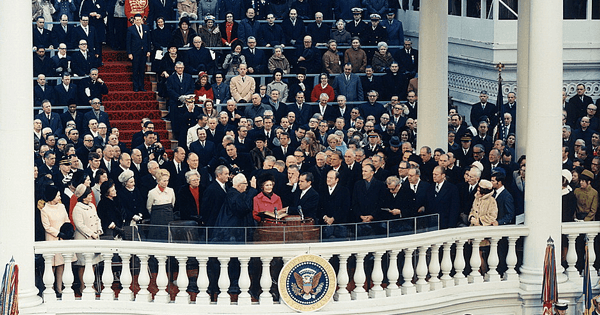A Tale of Two Concerts
Music meant politics at Richard Nixon’s second inauguration

On a cold, wet January night in 1973, Richard Nixon and his entourage descended upon the Kennedy Center Concert Hall to hear Eugene Ormandy conduct the Philadelphia Orchestra. The concert was one of the highlights of Nixon’s second inaugural, and though Washington’s National Symphony Orchestra usually performed at such events, the president had a particular love for the Fabulous Philadelphians, as the storied ensemble with the plush string sound and bright, resonant brass was once known. The program included Beethoven’s Fifth Symphony and Copland’s Fanfare for the Common Man, and Van Cliburn appeared as soloist in the Grieg Piano Concerto. Not everyone, however, was thrilled to be there. Sixteen members of the Philadelphia Orchestra asked to be excused on principle—a request that was swiftly denied. The musicians in question were especially rankled by the choice of the concert’s closing work, Tchaikovsky’s 1812 Overture. How could they be forced to perform the musical apotheosis of military bombast, given all that was happening in Vietnam? As the late Neil Courtney, a long-time double bassist with the orchestra, put it at the time, “The atmosphere is like Germany in the 1930s, the same confusion of values … it’s bizarre.”
The more things change, I’m tempted to say.
And yet, what artist performing at this weekend’s inaugural festivities even inhabits the same galaxy as a Eugene Ormandy or Van Cliburn? Say what you want about Nixon, but I can’t help feeling the slightest bit wistful for a president who could extoll the virtues of Grieg’s Piano Concerto (as he did during a late-night phone call to Charles Colson, hours after the inaugural concert had ended), and who could have played several bars of the work himself.
That same night of January 19, 1973, another illustrious performance took place—a concert of protest—just a few miles north of the Kennedy Center, inside the hallowed precincts of the Washington National Cathedral. The star of this “Concert for Peace” was none other than Leonard Bernstein, and the work he chose to perform was Haydn’s Mass in the Time of War. Haydn wrote the piece in 1796, despondent over the fate of Austria in the aftermath of the French Revolution. For Bernstein, an artist never hesitant to use music to make a political statement, the Mass seemed to capture the tenor of his own war-weary era as well.
Nearly 2,500 people, including Sens. Edward Kennedy and Eugene McCarthy, among other dignitaries, crammed inside the cathedral, and loudspeakers broadcast the performance to more than 15,000 others gathered on the cathedral’s grounds, despite the rain and gusting wind. The next day, Bernstein and the musicians—soprano Patricia Wells, mezzo-soprano Gwendolyn Killebrew, baritone Alan Titus, and bass-baritone Michael Devlin; a four-part choir; and an orchestra drawn mainly from the ranks of the National Symphony—returned to the cathedral to record the work for the Columbia label. This LP has been in my collection for some years, and recently, I’ve found myself returning to it over and over again. You’d never know that the recording wasn’t live—it lacks nothing in the way of frisson or spontaneity, and every phrase bears the mark of Bernstein’s brilliant conducting. The reading is expansive and idiomatic, full of feeling from the first notes of the Kyrie—a solemn, hazy beginning not unlike that of Haydn’s oratorio The Creation, composed around the same time as this Mass. Out of this nebulous cloud comes the most startling burst of musical light. Indeed, so much of the Mass in the Time of War (like the Roman Catholic liturgy upon which it is based) alternates between melancholy and exuberance: the Gloria, with its heavenly cello line and brooding baritone solo, full of heartbreak as the singer lands on the words miserere nobis (have mercy on us); the Credo, at once somber and ebullient; the Benedictus, too, with the foreboding presence of the timpani giving way, once the voices enter, to the most glowing, pure, and lovely sound. When we come to the concluding Agnus Dei, we can sense the full depths of Haydn’s despair. What was he trying to convey with those hammer strokes of the timpani, the very instrument that gives the Mass its second name—Paukenmesse (the word Pauke meaning timpani)? Are they meant to be the drumbeat of war? Or fate knocking upon our earthly doors?
Tchaikovsky’s 1812 Overture may end with brazen cannon fire, but Haydn’s Mass contains nothing so lurid or crude. Indeed, by the work’s end, the mood has brightened, and the character of the timpani seems to have transformed. No more intimations of death, only music of celebration and joy. Not surprising, given that the final word of the piece is pacem, or peace.
These days, I’m trying to listen to this recording with as much hope as I can muster. The work seems as necessary now as it must have been in 1796, or 1973, the year that I was born. Yet again, I’m tempted to say, the more things change … Before the Concert for Peace commenced, the dean of the Washington National Cathedral, Francis B. Sayre Jr., intoned the following prayer:
Mend, Lord, the brokenness of mankind; our brutal blinders, the willful lack of care. Heal the angry wounds we anonymously inflict upon each other. Grant us more than momentary respite from the gory dance; but rather that we may know the deeper patience of a brother’s love, and see the shadow of Thy holiness writ upon each human face—brown and yellow, and white, and black, masked now by the agony of man.
I may not have a religious corpuscle in my bloodstream, but those words, as much as Haydn’s music, seem as compelling and urgent as ever.

